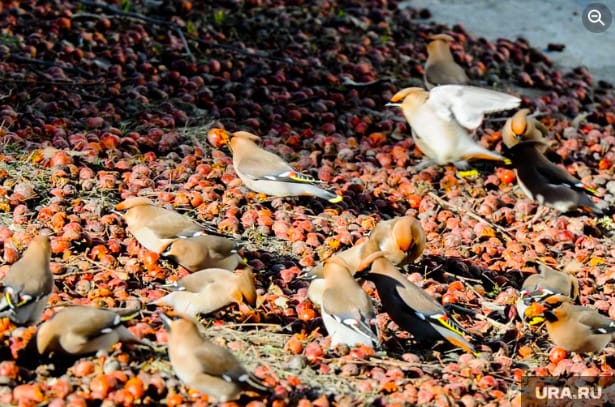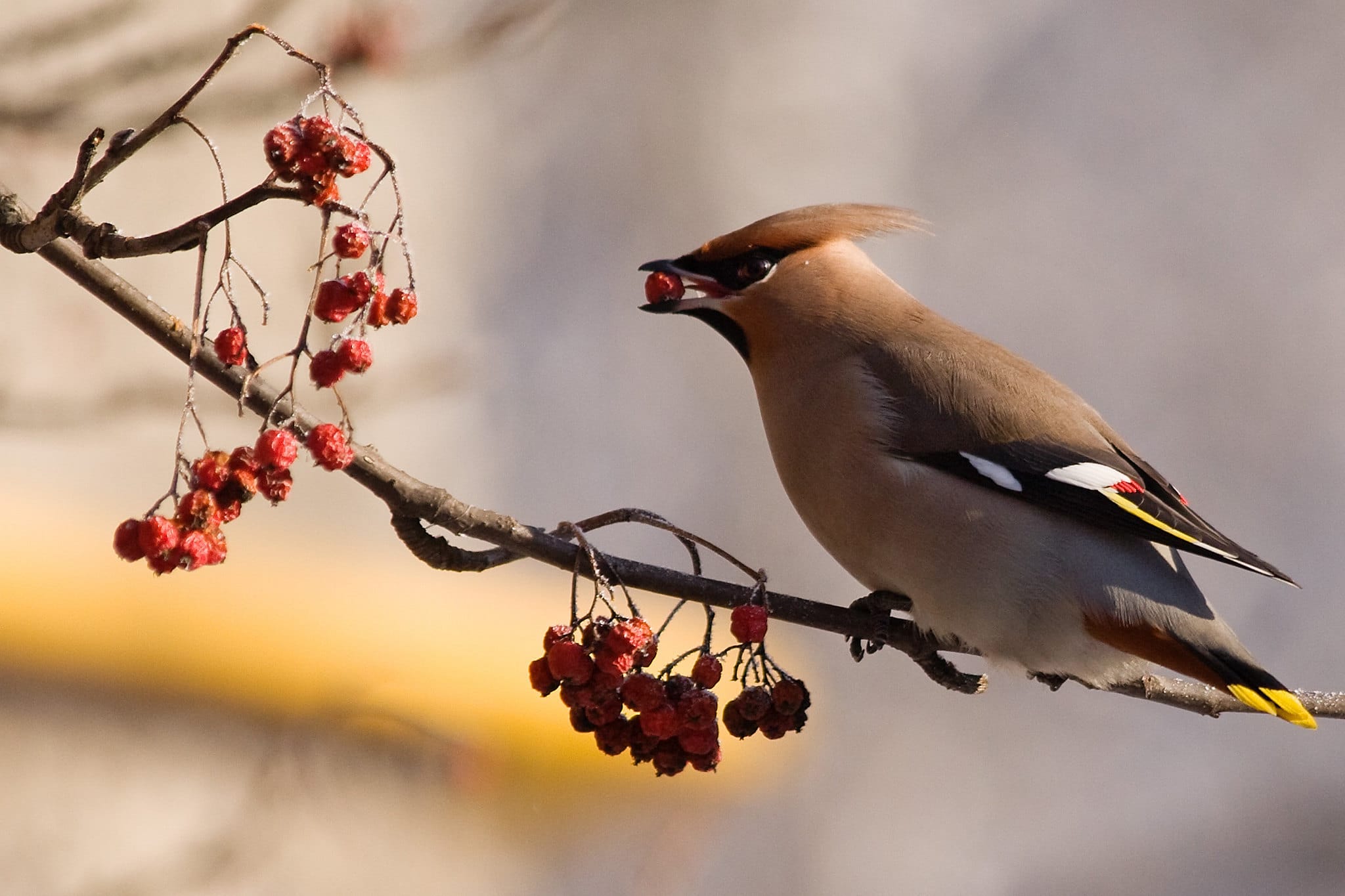Every autumn, the story of drunken waxwings gains popularity: the birds peck at fermented rowan trees and then fall straight onto the streets. Such publications usually advise putting the bird in a safe place so that it comes to its senses, or even setting up a sobering-up station for the bird on your balcony. We decided to check out the story about the feathered drunkards, and also explore whether it is worth following the recommendations for saving them.
Warnings about drunken birds come from different regions of Russia: Moscow, St. Petersburg, Chelyabinsk, Samara, Novosibirsk, Tyumen, Vologda, Kirovskaya, Lipetskaya And Kaluga regions. However, reports vary in detail. So, in some posts about Moscow and the Moscow region it is stated that drunken waxwings are autumn phenomenon (“usually bullfinches, waxwings and other birds - berry lovers get drunk in the warm and humid autumn”), in others - winter (“in winter, due to temperature changes, its fruits [rowan] can ferment right on the branches, and the birds, having tasted the berries, get drunk”), and in the third - spring (“Drunken waxwings have been spotted in the Moscow region. These birds appear in cities in early spring, when there is nothing to eat in the forests and they have to move closer to people.”) Journalists from some media they're joking about drunken birds: “You’re walking down the street, you see a waxwing lying in Drabadan, go around it, don’t pester it. If he doesn't pester you himself, of course. Well, the bird drank, maybe it had a hard week." or “Drunk feathered: among the capital’s birds there were “involuntarily alcoholics”.” Popular And numerous photos lying on the ground birds - it is stated that this is tipsy waxwings.

Waxwings - birds order of passeriformes, living in coniferous and mixed forests of the Northern Hemisphere. In summer, they feed mainly on insects and their larvae; their diet also includes berries and young shoots of plants. In cold weather, the basis of the diet is berries and fruits. Waxwings - birds migratory, they spend the summer in northern latitudes (marked in pink on the map), where they lay eggs and raise chicks, and in the fall they migrate south (marked in blue).
And although the basis of the winter diet of these birds is indeed rowan, biologists cast doubt on stories about the drunkenness of waxwings.
The first thing alarming about them is the very statement about the intoxicating berries. Not every autumn-winter temperature is conducive to fermentation and fermentation of berries. Senior researcher at the Moscow State University Zoo Museum, ornithologist Olga Voltsit explains: “The rowan on the trees is not fermented, it only dries out and does not ferment.” The process is explained in more detail by Anton Ivanov, a senior researcher at the Timiryazev State Biological Museum: “When we simply leave the berries, a fermentation process also occurs there, bacteria appear there that process this sugar. But this process requires high temperatures, and here they always talk about drunken birds in winter.” In autumn the berries usually ferment don't have time, then when sub-zero temperatures set in, they freeze and only thaw in the spring, which makes the fermentation process possible. It continues until the ethanol concentration stops the yeast's metabolism. Ethanol is then oxidized by bacteria to acetic acid. It turns out that there is a fairly narrow time window when ethanol is generally contained in berries.
The second strange thing in the story of drunken birds is that animals that eat fruits have quite a lot of alcohol dehydrogenase in their livers, the enzyme responsible for processing alcohol. His activity in waxwings it is 6.2 times higher than in greenfinches belonging to the same family and 15 times higher than in starlings that feed mainly on seeds. Because of this, the rate of ethanol metabolism in waxwings is extremely high - 900 mg/kg/h. For comparison, the normal metabolic rate of ethanol in humans is amounts to 180 mg/kg/h, that is, five times less than poultry. Moreover, evolution gave These birds have a large liver - it makes up 4.9% of their total body weight. A liver a person is only 2% of his weight. Such a significant liver should allow birds to eat even fermented berries without significant health risks.
At the same time, waxwings in winter really eat an astonishing number of berries - 800-1000 per day, or twice your own body weight. Therefore, an overfed waxwing may experience problems with coordination and crash into surrounding objects. Moreover, these birds are accustomed to living in the forest, so in the city, even for sober birds, any transparent barriers pose a danger: window glass, plastic transparent bus stops, shop windows, etc. Some countries, concerned about this problem, install special bus stops with markers in the form of dots located at equal distances. Such appeared, for example, in Poland.
According to the Polish Glass Traps Foundation, up to a million birds a year die in the country from injuries sustained in collisions with transparent surfaces.
Megan Larivee, laboratory coordinator for the government agency Environment Yukon in Canada, explainsthat a convenient breathalyzer for birds simply does not exist. Moreover, a person cannot always distinguish a bird with a significant blood alcohol content from its sober counterparts. First of all, intoxication causes a lack of coordination of movements in flight, which can lead to the bird crashing into something and getting injured.
In March 1974, there were 16 waxwings in Canada discovered dead, before that they ate fermented fruits of an apple tree, and when they took off from it, they crashed into the windows and walls of the nearest building. In April 1989, there were two waxwings in the United States died, falling from the roof. The cause of death was internal hemorrhage as a result of hitting the ground, and high levels of ethanol in the blood were also noted. In 2012, in the suburbs of Los Angeles, California, there were also discovered dead waxwings - they also died as a result of injury, ethanol was also found in their blood. It turns out that in all cases the cause of death was a collision, and ethanol led to a lack of coordination. In one of the viral photos of supposedly drunk waxwings, depicted a flock of waxwings crashed into a bus stop in front of eyewitnesses - 14 birds died, one survived.
However, media reports usually do not talk about birds that have fallen to their death, but about those that lie on the ground without injury. A possible reason for this behavior of birds explains Olga Voltsit: “When birds eat a lot of cold berries in the cold, their metabolic rate drops greatly - when their stomachs are full of cold things, they fall into a stupor and fall into the snow. And then the berries inside them warm up, digest, and they “come to life.” This is probably what happened, that is, they were not drunk, but simply hypothermic.” She also confirms that birds sometimes collide with storefronts and windows in cities, but explains this not by drunkenness: “The birds migrated to the city and found themselves in an unfamiliar area.” At the same time, zoologists usually do not take into account temporarily numb birds, unlike the dead.
If we proceed from this explanation of the reasons for the fall of waxwings, it will become clear that if they need any help, it is certainly not placement in a sobering-up center. If a bird crashes into an obstacle and is seriously injured, being in a sobering station without a veterinary examination will not help it; at best, it will protect it from further injuries from cars and animals. If a bird has fallen into a stupor after eating cold berries, then it does not need help - their body copes with such problems on its own. Moreover, it is unknown how a bird’s body will behave with cold berries inside when it finds itself in a warm room.
Thus, photographs of waxwings lying on the ground and supposedly drunk show either birds that crashed into some kind of obstacle, or those who simply gorged themselves on cold berries. Visually distinguishing one from another can be difficult for a non-professional. However, it is incorrect to consider waxwings as drunkards: the body of these birds is designed in a special way, which allows them to process a significant amount of alcohol - five times more, adjusted by weight, than a person could process. And although science knows of isolated cases of discovering dead birds with ethanol in their blood, all of them died as a result of crashing into glass or other transparent object.
Cover image: Flickr, Yuri Timofeyev
If you find a spelling or grammatical error, please let us know by highlighting the error text and clicking Ctrl+Enter.






